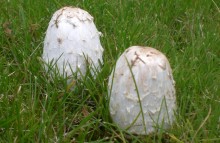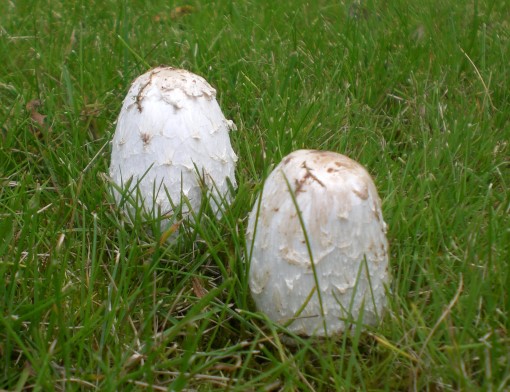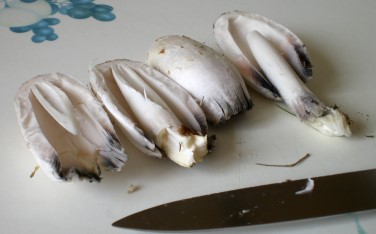Shaggy Inkcaps
By Mike on Sunday, September 26, 2010, 20:07 - Permalink
 If you're lucky enough to find a patch of these mushrooms, you're in for a treat. Shaggy Inkcaps are delicious, but are so delicate and ephemeral, you'll need to pick and cook them straight away.
If you're lucky enough to find a patch of these mushrooms, you're in for a treat. Shaggy Inkcaps are delicious, but are so delicate and ephemeral, you'll need to pick and cook them straight away.
Identification Of Wild Fungi
The description here is not intended to be sufficient for conclusive identification of these wild fungi - the reader should understand that the possible outcomes of misadventure with wild-gathered fungi include serious illness and death.IT IS YOUR OWN RESPONSIBILITY to take adequate steps in identifying any fungi you gather for the table - doubly so if you are intending to share them with someone else.
Informal descriptions, such as the one on this page, are not adequate for full identification - it's just good sense to fully and independently verify everything you read here.
Rules of thumb or folk wisdom identification methods are frequently unreliable.
Consult a comprehensive identification guide (I recommend Roger's Mushrooms (site no longer available - see here) and Wild Mushrooms Online) or best of all, talk to a living human expert mycologist.

What Are Shaggy Inkcaps?
Coprinus comatus - also known as Lawyer's Wig or just Shaggy Caps, this mushroom is most commonly found in grass or pastures, especially where the soil has been disturbed or infilled previously. For this reason, they often appear on grass verges and lawns around new properties and developments.
They're exceptionally fast growing - pushing through the turf as little scaly buttons, they develop fast into tall, elongated-egg-shaped mushrooms and may grow as tall as 30cm in the space of a single day, with the scales turning more shaggy as the cap develops.
In the early stages, the flesh of the cap and gills is pure, slightly translucent white, with a pleasant earthy, mushroomy scent, but soon changes through pink and brown to black, whereupon the whole cap starts to decompose into a black liquid (hence the name inkcap).
Picking Shaggy Inkcaps
Shaggy Inkcaps are only worth picking them if you find them in good, young condition where the flesh is still white, and when you have the opportunity to cook them within an hour of picking. They don't store or travel well at all.
Another species in this genus - the common inkcap, Coprinus atramentarius - mentioned here - is edible, but causes deeply unpleasant symptoms if consumed with alcohol (or within a short time before or afterwards).
Supposedly, this is not an attribute shared by Shaggy Inkcaps, however, I've always erred on the side of caution, because one of my wild food reference books does warn against it (perhaps erroneously).
 I only found a couple of fairly small specimens less than 10cm tall. They were quite difficult to pick, as the turf was very thick and dense, and the cap extends almost to the base of the stem.
I only found a couple of fairly small specimens less than 10cm tall. They were quite difficult to pick, as the turf was very thick and dense, and the cap extends almost to the base of the stem.
These are probably at the limit of edibility - beginning to turn dark at the fringes of the cap already.
 Even during the twenty minute journey home, the two mushrooms I found had lost some of their condition.
Even during the twenty minute journey home, the two mushrooms I found had lost some of their condition.
I trimmed a little of the dark portion off the bottom and cooked them anyway - I don't have a photo of this, because they cook incredibly fast and I didn't dare leave them unattended for a second.
Eating Shaggy Inkcaps
Shaggy Inkcaps are very tasty - I've eaten them several times before and in my experience, they have a rich flavour that makes them taste like they've been cooked in butter even if they have only been lightly fried in a neutral tasting vegetable oil.
They are very soft and delicate and cook in a minute or less, so prepare everything else first and start the mushrooms at the last minute.
